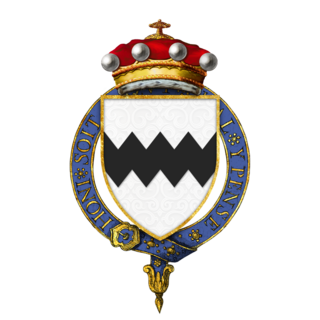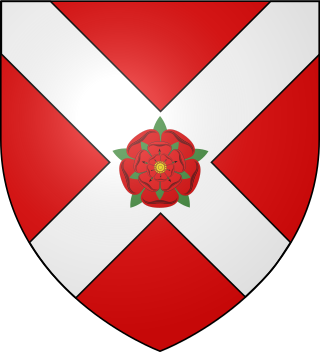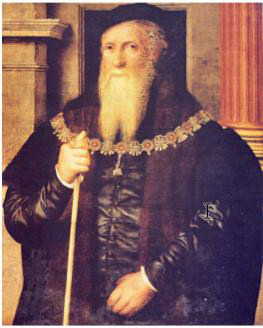
Sir Robert Wingfield (died 1454), of Letheringham in Suffolk, [1] was an English landowner, administrator and politician. [2] [3] [4]

Sir Robert Wingfield (died 1454), of Letheringham in Suffolk, [1] was an English landowner, administrator and politician. [2] [3] [4]
Born in about 1403, he was the son of Sir Robert Wingfield (died 1409) by his wife Elizabeth Russell, daughter of Sir John Russell (d.1405), of Strensham in Worcestershire and his first wife Agnes. The elder Robert was son of Sir John Wingfield and his wife Margaret Hastings (died 1397), [4] later second wife of Russell. As guardian of her son, it was Russell who arranged the marriage of Robert to his daughter Elizabeth. [5]
He is thought to have been kin, although the precise nature of the relationship is unknown, to Sir John de Wingfield (fl.c.1350) of Wingfield Castle in Suffolk, about 12 miles north of Letheringham, chief administrator to Edward the Black Prince (1330-1376), whose daughter and heiress Catherine Wingfield married Michael de la Pole, later 1st Earl of Suffolk, and lived at Wingfield Castle in Suffolk.
In 1420 he was a legatee in the will of his great-aunt Elizabeth Elmham, [4] and in 1426 was knighted at Hereford by King Henry VI. [4] The next year he was elected a knight of the shire for Suffolk and sat in all Parliaments until 1436.[ citation needed ]
In 1436 he was appointed steward of the lands in Norfolk of the Honour of Richmond and in 1443 he became steward to John de Mowbray, 3rd Duke of Norfolk and accompanied him on his embassy to the court of King Charles VII of France.[ citation needed ]
In December 1447 he was named as a rioter in Suffolk and was imprisoned in the Marshalsea, but was pardoned in February 1448. In September of that year he complained that the Duke of Norfolk had attacked his home at Letheringham with an armed force and had burned his furniture and removed goods worth the then huge sum of £1,200. [4]
Despite these local difficulties, in 1449 he was elected a Member of Parliament for Hertfordshire,[ citation needed ] but was denounced in Parliament next year as one of the King's "evil advisors". [4]
Before 18 August 1421 he married Elizabeth Goushill (born circa 1402), a daughter of Sir Robert Goushill of Hoveringham in Nottinghamshire, by his wife Elizabeth Fitzalan. Elizabeth Goushill was co-heiress of her father's estate along with her sister Joan Goushill, the wife of Thomas Stanley, 1st Baron Stanley, and their half-brother was John de Mowbray, 2nd Duke of Norfolk. Robert Wingfield had twelve children by Elizabeth, who survived him:
He died in 1454 and was buried at Letheringham. His will, made on 6 October 1453, was proved on 21 Nov 1454. [4]
Thomas Grey, 1st Marquess of Dorset, 1st Earl of Huntingdon, 7th Baron Ferrers of Groby, was an English nobleman, courtier and the eldest son of Elizabeth Woodville and her first husband Sir John Grey of Groby. Her second marriage to King Edward IV made her Queen of England, thus elevating Grey's status at court and in the realm as the stepson of the King. Through his mother's assiduous endeavours, he made two materially advantageous marriages to wealthy heiresses, the King's niece Anne Holland and the King’s cousin, Cecily Bonville, 7th Baroness Harington. By the latter, he had 14 children.
Elizabeth de Mowbray, Duchess of Norfolk was an English noblewoman and the wife of Thomas Mowbray, 1st Duke of Norfolk.

Sir Richard WingfieldKG of Kimbolton Castle was an influential courtier and diplomat in the early years of the Tudor dynasty of England.

John Mowbray, 3rd Duke of Norfolk, KG, Earl Marshal was a fifteenth-century English magnate who, despite having a relatively short political career, played a significant role in the early years of the Wars of the Roses. Mowbray was born in 1415, the only son and heir of John de Mowbray, 2nd Duke of Norfolk, and Katherine Neville. He inherited his titles upon his father's death in 1432. As a minor he became a ward of King Henry VI and was placed under the protection of Humphrey, Duke of Gloucester, alongside whom Mowbray would later campaign in France. He seems to have had an unruly and rebellious youth. Although the details of his misconduct are unknown, they were severe enough for the King to place strictures upon him and separate him from his followers. Mowbray's early career was spent in the military, where he held the wartime office of Earl Marshal. Later he led the defence of England's possessions in Normandy during the Hundred Years' War. He fought in Calais in 1436, and during 1437–38 served as warden of the east march on the Anglo-Scottish border, before returning to Calais.

Thomas West, 8th Baron De La Warr and 5th Baron West, KB, KG was an English courtier and military commander during the reigns of Henry VII and Henry VIII.

The title Baron Grey of Powis (1482–1552) was created for the great-grandson of Joan Charleton, co-heiress and 6th Lady of Powis (Powys) and her husband, Sir John Grey, 1st Earl of Tankerville (1384–1421) after the death of Joan's father, Edward Charleton, 5th Baron Cherleton (1370–1421) left the title in abeyance.

Edward Neville, de facto 3rd Baron Bergavenny was an English nobleman.
John de Vere, 12th Earl of Oxford, was the son of Richard de Vere, 11th Earl of Oxford, and his second wife, Alice Sergeaux (1386–1452). A Lancastrian loyalist during the latter part of his life, he was convicted of high treason and executed on Tower Hill on 26 February 1462.
The Blois family have been substantial landowners in Suffolk for several centuries. Until recently the family home was at Cockfield Hall in Yoxford, Suffolk, a Grade 1 listed private house standing in 40 acres (160,000 m2) of historic parkland.

Wingfield Castle in the parish of Wingfield in Suffolk, England is a fortified manor house which was the ancestral home of the Wingfield family and their heirs, the de la Pole family, created Earls and Dukes of Suffolk. It is now a private house. Sir John de Wingfield, of Wingfield, chief administrator to Edward the Black Prince (1330–1376), was the last male of his line, whose daughter and heiress Catherine Wingfield married Michael de la Pole, seated at Wingfield Castle, who in 1385 was created Earl of Suffolk. His descendant Edmund de la Pole, 3rd Duke of Suffolk (1472–1513) was forced to surrender his dukedom in 1493. It was resurrected by King Henry VIII in 1514 for his favourite Charles Brandon, 1st Duke of Suffolk (1484–1545), who although he had no close connection with Wingfield Castle and the county of Suffolk, was a great-grandson of Sir Robert Wingfield, of Letheringham in Suffolk, about 12 miles south of Wingfield.

Thomas Grey, 2nd Marquess of Dorset was an English peer, courtier, soldier and landowner of the House of Grey.

Letheringham is a sparsely populated civil parish in the East Suffolk district in Suffolk, England, on the Deben River.
Sir Humphrey Wingfield was an English lawyer and Speaker of the House of Commons of England between 1533 and 1536.
Sir Henry Jerningham KB was an English courtier during the Tudor period. He was a Gentleman Pensioner during the reign of Henry VIII. In the succession crisis of 1553 he was one of the foremost supporters of Mary Tudor, and after her accession was one of her most trusted servants, being appointed Vice-Chamberlain of the Household, Captain of the Yeomen of the Guard, and a member of the Privy Council.

Sir Anthony Wingfield KG, MP, of Letheringham, Suffolk, was an English soldier, politician, courtier and member of parliament. He was the Lord Lieutenant of Suffolk from 1551 to 1552, and Vice-Chamberlain of the Household in the reign of Edward VI.
Sir Robert Wingfield was an English diplomat.

Sir Thomas Brandon, of Southwark, Surrey, and of Duddington, Northamptonshire, KG was an English soldier, courtier and diplomat.

Sir William Brandon, of Wangford in Suffolk, was an English landowner, administrator, soldier, courtier and politician. His grandson was Charles Brandon, 1st Duke of Suffolk, a courtier and close friend of King Henry VIII.

Sir John Howard, of Wiggenhall and East Winch, in Norfolk, England, was a landowner, soldier, courtier, administrator and politician. His grandson was John Howard, 1st Duke of Norfolk, the great-grandfather of two queens, Anne Boleyn and Catherine Howard, two of the six wives of King Henry VIII.
Sir John Russell, of Strensham in Worcestershire where he held the manor and advowson, was an English landowner, soldier, administrator, courtier and politician.